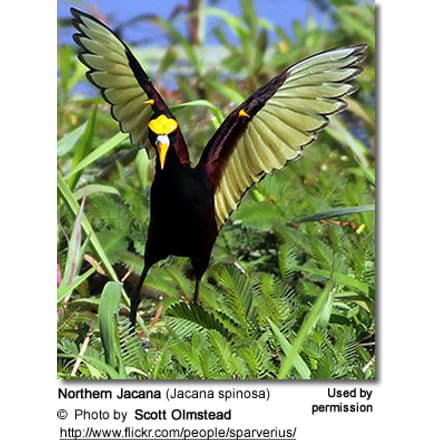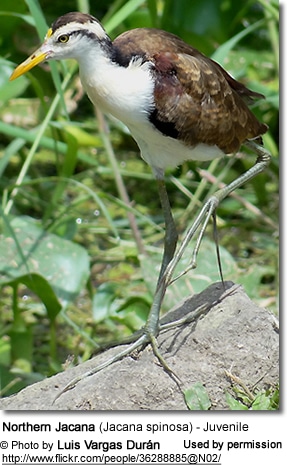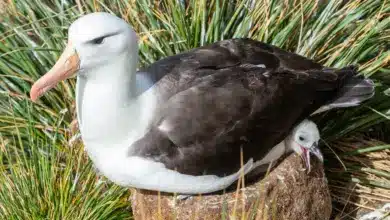Northern Jacana or Middle American Jacanas or Mexican Jaçanas
The Northern Jacana (Jacana spinosa) are wetland birds with a range that stretches from southern USA south to Central America.
They are known by a variety of names, including American or Middle American Jacanas, Mexican Jaçanas or, simply, Jaçanas.
Jacanas spend a good part of their days on floating vegetation as they feed on insects on the surface of vegetation and the ovules of water lilies.
In Jamaica, these medium-sized waders are commonly referred to as “Jesus Birds” based on their habit of walking on floating vegetation in shallow waters, giving them the appearance to walk on water.
For this same reason, these birds have also been nick-named “lily trotters“.
Jacana Information and Listing of Species … Jacana Photo Gallery
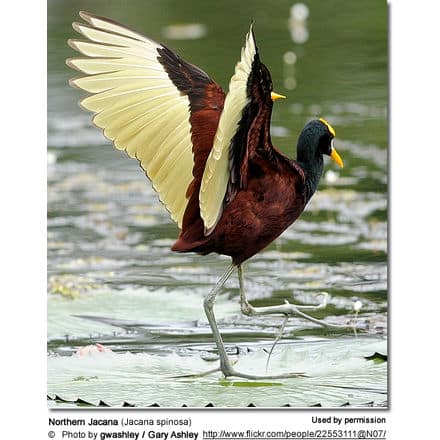
The physical traits that allow them to “walk on water” are …
- small body size (only about the size of a robin), in combination with
- long, slender toes that spread out to cover an area of 4.7 – 5.5 inches (12 – 14 cm) thus dispersing the weight over a large area.
Another peculiar aspect of this species is that the dominant female is polyandrous (mates with several males) – and she is often referred to as “the prostitute bird.” She is also not the primary care takers of the young. The male incubates the eggs, and feeds and protects the young.
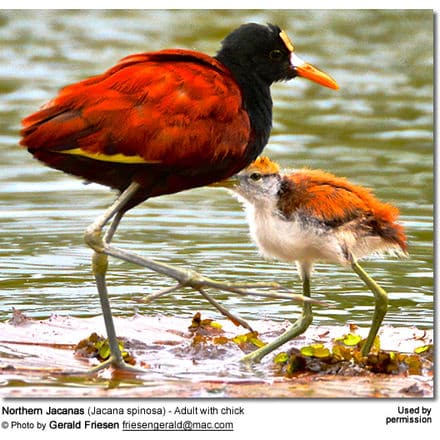
Distribution / Habitat
Northern Jacanas are distributed from southern Texas south through coastal Mexico – along the Gulf slope from Tamaulipas on Gulf of California to Yucatan and on the Pacific slope from Sinaloa to the south – to western Panama.
They are also found on the islands of Cuba, Jamaica and Hispaniola and the West Indies. Vagrants have been reported in Arizona.
Jacanas are resident (non-migratory) within their range and maintain home territories for feeding and breeding. They aggressively defend their territories using as weapons the spurs on the bend of the wing.
These birds are native to the following …
Islands: Belize, Cuba, Hispaniola (Dominican Republic and Haiti), and Jamaica
Countries: Costa Rica, Dominican Republic, El Salvador; Guatemala, Honduras, Mexico, Nicaragua, Panama, Puerto Rico, United States
Habitats: Fresh water marshes, swamps, pond edges, roadside ditches, lake margins, river beds and lagoons with aquatic vegetation
May occasionally be seen in flooded fields or wet grassy areas
Altitude: From sea level to 4,000 feet or ~ 1200 meters
Subspecies and Ranges:
The three are very similar in appearance.
- Northern Jacana, American Jacana (nominate) (Jacana spinosa spinosa – Linnaeus, 1758)
- Range: Belize and Guatemala south to western Panama
- Ja̤ana, Mexican Jacana, Mexican Ja̤ana, Middle American Jacana or Northern Jacana (ssp. gymnostoma) (Jacana spinosa gymnostoma РWagler, 1831)
- Range: Mexico, from south central Sinaloa and central Tamaulipas south to Chiapas, the Yucatán Peninsula and the island of Cozumel. A small number of them are found in southeastern Texas.
- West Indian Jacana (Jacana spinosa violacea – Cory, 1881)
- Range: Cuba, Isle of Pines, Jamaica and Hispaniola
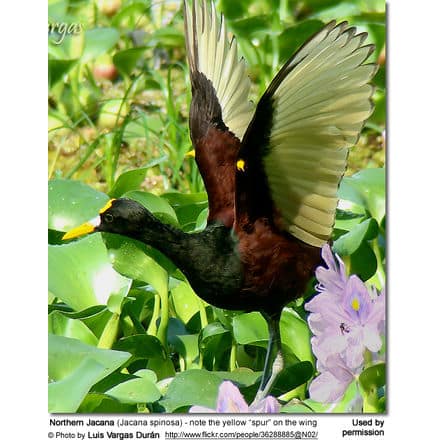
Description:
Size
Length: 6.7 – 9.4 inches or 17 – 24 cm.
Weight: 3.1 – 5.1 oz (87 – 145 g)
Wingspan: averages 20 inches or 51 cm
Gender ID
The larger females are about twice as big as males.
Plumage Details / Adults
- Back, under plumage and tail are dark brown / chestnut
- Head, neck and chest blackish
- Greenish-yellow patches on wings
- Pale green / yellow flight feathers (yellow mostly visible in flight or when they raise their wings)
- Long legs with long toes
- Pale green flight
Other Physical Details / Adults
- Black eyes
- Long, bright yellow bill (with a white base) that extends up to form a shield-like plate on the forehead
- Rounded wings
- Long, sharp spur on the wings
- Greyish or dull-yellow legs
- Extremely elongated toes
Juvenile Description
- Bi-colored plumage – with white underside and a darker back, head and neck
- Paler bill
- White supercilium (“eye brows”) and white lores (feathers covering the ears).
- Crown and stripe behind the eyes is brown
- Olive-brown back
- Dark brown flanks
- Dull yellow flight feathers
- Frontal shield reduced or absent.
Similar Species

Calls / Vocalizations / Sounds
Their vocalizations are described as ” harsh €œjik€ calls that progressively speed up to a chatter; and a whistling gnashed cui cui cuic cui cui.
Alternate (Global) Names
Chinese: ???? … Czech: Ostnák trnitý … Danish: Nordlig Jacana … Dutch: Jacana, Leljacana … Estonian: kuldlauk-lootoselind … Finnish: Amerikanjassana … French: Jacana à ailes jaunes, Jacana du Mexique, Jacana roux … German: Gelbstirn-Blatthühnchen, Gelbstirnjassana, Jassana … Irish: Seacana sporeiteach … Haitian Creole French: Doktè … Italian: Jacana del Centroamerica, Jacana spinosa … Japanese: amerikarenkaku … Norwegian: Gulpannebladhøne … Polish: dlugoszpon zóltoczelny, d?ugoszpon ?ó?toczelny … Russian: ?????????? ????? … Slovak: jakana ostnatá … Spanish: Gallito, Gallito de agua, Gallito de Agua Mejicano, Gallito de Dedos Largos, Jacana Centroamericana, jacana frente-amarilla, Jacana Norteña / Mesoamericana / Norteño … Swedish: Centralamerikansk jacana

